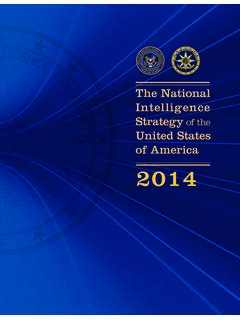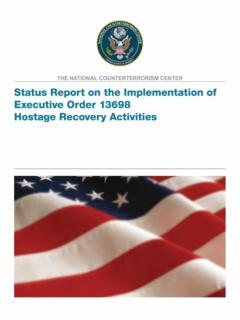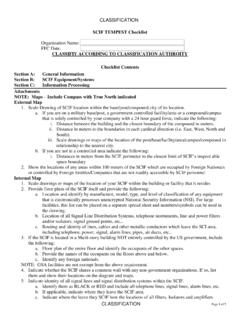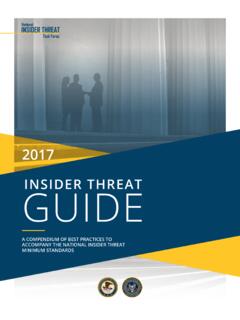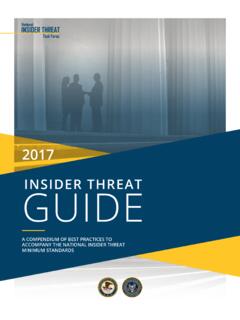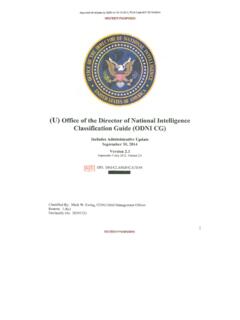Transcription of ODNI FACTSHEET - dni.gov
1 ODNI FACTSHEET The intelligence reform and terrorism prevention Act of 2004 established the Office of the Director of National intelligence (ODNI), which began operating in 2005. By statute, the DNI is the principal intelligence adviser to the President, and determines and manages the National intelligence Program (NIP) budget of more than $50 billion, the government s total intelligence spending aside from military intelligence . The DNI is also tasked with integrating the efforts of the 17 elements of the intelligence Community (IC).
2 FORMATION With the evolution from a Director of Central intelligence (DCI) to the DNI, ODNI s core staff came from the DCI s Community Management Staff (CMS), bringing their responsibility for the IC s management of information technology, human capital planning, technology research, Major Systems Acquisitions (MSA), facilities planning, and financial management. ODNI s duties expanded well beyond CMS, particularly with the DNI s authority and responsibility to determine the consolidated NIP. Within its first two years, ODNI also established an ability to conduct its own internal process, such as security and human resources.
3 COORDINATING KEY ACTIVITIES In its first year, the ODNI became responsible for the President s Daily Briefing staff and the National intelligence Council (NIC), previously housed within the Central intelligence Agency (CIA), to fulfill the DNI s role as principal intelligence advisor. ODNI also gained three IC mission-focused centers. The National Counterterrorism Center (NCTC), previously the Terrorist Threat Integration Center; the Office of the National Counterintelligence Executive, changed to the National Counterintelligence and Security Center in 2014; and the National Counterproliferation Center, formed from IC elements; as well as the Office of the Program Manager for the Information Sharing Environment were all established in 2005.
4 In 2007, the establishment of the intelligence Advanced Research Projects Activity integrated the previously disparate technology-research offices within the CIA, the National Geospatial- intelligence Agency, and the National Security Agency. Each of these community functions moved or coalesced into offices within the ODNI, which provided a central home outside of the agencies tasked with conducting specific intelligence and national security missions. ODNI began operations in April 2005. The DNI is the principal intelligence adviser to the President.
5 The DNI determines and manages the National intelligence Program budget of more than $50 billion. ODNI s mission centers produce coordinated intel on crucial threats to our national security: CT, CI, Cyber & WMDs. EMERGING MISSIONS Statutes and Presidential directives have assigned new missions to the ODNI, in addition to its initial responsibilities, including the establishment of the IC Inspector General in 2010 and the Cyber Threat intelligence Integration Center in 2016. These new components did not add to the ODNI s staff size.
6 STAFFING & SUPPORT Since late 2007, the number of military and government civilian employees at the ODNI has remained relatively constant, with the exception of a small surge of NCTC staff after the failed Christmas Day bombing attempt in 2009. Of the ODNI s fewer-than-2000 people, more than half work in the mission-focused centers; moreover, 40 percent of ODNI employees are on rotation from the other 16 IC elements. Unlike some other headquarters elements, the ODNI employs fewer contractors than government and military staff, and while the military and government employee population has remained steady at the ODNI, the number of core contractors has dropped by about a quarter since 2009.
7 MANAGEMENT EFFICIENCY While the overall size of the ODNI staff has remained relatively constant and core contractor support has decreased, the ODNI s mission has grown. ODNI has taken on new roles to meet the DNI s obligations to lead the IC and manage the NIP under the existing 2004 law. In 2009, the DNI formed the Systems and Resource Analyses (SRA) component to conduct community-focused studies and evaluations. In collaboration with the Acquisition, Technology & Facilities component, SRA helped bring IC MSAs back on track.
8 In 2007, almost all MSAs were off schedule and off budget. Today all MSAs are in the green, meeting the IC s obligations of responsible stewardship of NIP funding and effective integration of technology and technical research. This is just one tangible example of how ODNI s leadership in IC integration has paid big dividends for the Community and the American taxpayer. intelligence INTEGRATION In 2010, the DNI established the largest of the ODNI s management and integration components by merging the ODNI s collection and analysis elements under a single Deputy Director of National intelligence for intelligence Integration.
9 ODNI s staff and capabilities are drawn from existing IC elements. 40% of ODNI employees are on rotation from one of the other 16 IC elements. ODNI s centers account for more than half of its workforce, which is fewer than 2,000 people. ODNI evaluates the effectiveness of programs and spending across the IC to keep them on track. The ODNI s National intelligence Managers, each responsible for evaluating a global region (such as Near East or Africa) or intelligence function (such as Counterintelligence or Cyber), promote better-integrated and more-focused planning for all collection, CI, budget, and analytic efforts across IC elements.
10 The NIC s production of the strategic analysis ensures that senior US Government decision-makers benefit from insights of the entire IC when making critical national security decisions. COLLABORATION & INNOVATION To meet the funding level set by the Budget Control Act of 2011, the Chief Financial Officer established an IC-wide effort, convening senior IC leaders to collaboratively develop a strategic approach to fund key new investments and balance competing demands on limited resources. The ODNI negotiated the necessary NIP reduction over 10 years to meet legislated debt reduction, managing the IC s resources as an integrated and corporate asset and developing a strategy focused on cutting lower priority missions, seeking efficiencies, and accepting prudent risk, keeping in perspective investments needed to address future IC requirements.
